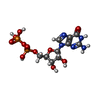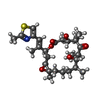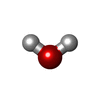+ Open data
Open data
- Basic information
Basic information
| Entry | Database: PDB / ID: 9pnd | ||||||
|---|---|---|---|---|---|---|---|
| Title | In situ microtubule of EpoB-induced regenerating axons | ||||||
 Components Components |
| ||||||
 Keywords Keywords | STRUCTURAL PROTEIN / cytoskeleton / microtubules / neuroregeneration / axon | ||||||
| Function / homology |  Function and homology information Function and homology informationMicrotubule-dependent trafficking of connexons from Golgi to the plasma membrane / Cilium Assembly / Sealing of the nuclear envelope (NE) by ESCRT-III / Carboxyterminal post-translational modifications of tubulin / Intraflagellar transport / COPI-independent Golgi-to-ER retrograde traffic / netrin-activated signaling pathway / netrin receptor binding / HSP90 chaperone cycle for steroid hormone receptors (SHR) in the presence of ligand / COPI-mediated anterograde transport ...Microtubule-dependent trafficking of connexons from Golgi to the plasma membrane / Cilium Assembly / Sealing of the nuclear envelope (NE) by ESCRT-III / Carboxyterminal post-translational modifications of tubulin / Intraflagellar transport / COPI-independent Golgi-to-ER retrograde traffic / netrin-activated signaling pathway / netrin receptor binding / HSP90 chaperone cycle for steroid hormone receptors (SHR) in the presence of ligand / COPI-mediated anterograde transport / Aggrephagy / Kinesins / Mitotic Prometaphase / EML4 and NUDC in mitotic spindle formation / Resolution of Sister Chromatid Cohesion / PKR-mediated signaling / The role of GTSE1 in G2/M progression after G2 checkpoint / RHO GTPases activate IQGAPs / Recycling pathway of L1 / dorsal root ganglion development / axonemal microtubule / COPI-dependent Golgi-to-ER retrograde traffic / RHO GTPases Activate Formins / Separation of Sister Chromatids / organelle transport along microtubule / Hedgehog 'off' state / Loss of Nlp from mitotic centrosomes / Recruitment of mitotic centrosome proteins and complexes / Loss of proteins required for interphase microtubule organization from the centrosome / Recruitment of NuMA to mitotic centrosomes / Anchoring of the basal body to the plasma membrane / forebrain morphogenesis / AURKA Activation by TPX2 / Regulation of PLK1 Activity at G2/M Transition / cerebellar cortex morphogenesis / glial cell differentiation / dentate gyrus development / neuron projection arborization / flagellated sperm motility / MHC class II antigen presentation / response to L-glutamate / pyramidal neuron differentiation / centrosome cycle / smoothened signaling pathway / regulation of synapse organization / startle response / adult behavior / motor behavior / response to tumor necrosis factor / locomotory exploration behavior / microtubule polymerization / response to mechanical stimulus / sperm flagellum / intercellular bridge / cytoplasmic microtubule / condensed chromosome / neurogenesis / peptide binding / homeostasis of number of cells within a tissue / axon guidance / cellular response to calcium ion / adult locomotory behavior / cell periphery / hippocampus development / filopodium / neuromuscular junction / locomotory behavior / intracellular protein transport / recycling endosome / synapse organization / cerebral cortex development / visual learning / structural constituent of cytoskeleton / microtubule cytoskeleton organization / memory / cytoplasmic ribonucleoprotein granule / neuron migration / neuron differentiation / mitotic spindle / myelin sheath / lamellipodium / microtubule cytoskeleton / growth cone / neuron apoptotic process / gene expression / Hydrolases; Acting on acid anhydrides; Acting on GTP to facilitate cellular and subcellular movement / microtubule / hydrolase activity / protein heterodimerization activity / axon / neuronal cell body / GTPase activity / synapse / dendrite / GTP binding / protein-containing complex binding / metal ion binding / identical protein binding / plasma membrane / cytoplasm Similarity search - Function | ||||||
| Biological species |  | ||||||
| Method | ELECTRON MICROSCOPY / helical reconstruction / cryo EM / Resolution: 3.19 Å | ||||||
 Authors Authors | Bodakuntla, S. / Taira, K. / Yamada, Y. / Alvarez-Brecht, P. / Cada, A.K. / Basnet, N. / Zhang, R. / Martinez-Sanchez, A. / Biertumpfel, C. / Mizuno, N. | ||||||
| Funding support |  United States, 1items United States, 1items
| ||||||
 Citation Citation |  Journal: Nature / Year: 2025 Journal: Nature / Year: 2025Title: In situ structural mechanism of epothilone-B-induced CNS axon regeneration Authors: Bodakuntla, S. / Taira, K. / Yamada, Y. / Alvarez-Brecht, P. / Cada, A.K. / Basnet, N. / Zhang, R. / Martinez-Sanchez, A. / Biertumpfel, C. / Mizuno, N. | ||||||
| History |
|
- Structure visualization
Structure visualization
| Structure viewer | Molecule:  Molmil Molmil Jmol/JSmol Jmol/JSmol |
|---|
- Downloads & links
Downloads & links
- Download
Download
| PDBx/mmCIF format |  9pnd.cif.gz 9pnd.cif.gz | 351.5 KB | Display |  PDBx/mmCIF format PDBx/mmCIF format |
|---|---|---|---|---|
| PDB format |  pdb9pnd.ent.gz pdb9pnd.ent.gz | 281.8 KB | Display |  PDB format PDB format |
| PDBx/mmJSON format |  9pnd.json.gz 9pnd.json.gz | Tree view |  PDBx/mmJSON format PDBx/mmJSON format | |
| Others |  Other downloads Other downloads |
-Validation report
| Summary document |  9pnd_validation.pdf.gz 9pnd_validation.pdf.gz | 1.9 MB | Display |  wwPDB validaton report wwPDB validaton report |
|---|---|---|---|---|
| Full document |  9pnd_full_validation.pdf.gz 9pnd_full_validation.pdf.gz | 1.9 MB | Display | |
| Data in XML |  9pnd_validation.xml.gz 9pnd_validation.xml.gz | 64.8 KB | Display | |
| Data in CIF |  9pnd_validation.cif.gz 9pnd_validation.cif.gz | 96.3 KB | Display | |
| Arichive directory |  https://data.pdbj.org/pub/pdb/validation_reports/pn/9pnd https://data.pdbj.org/pub/pdb/validation_reports/pn/9pnd ftp://data.pdbj.org/pub/pdb/validation_reports/pn/9pnd ftp://data.pdbj.org/pub/pdb/validation_reports/pn/9pnd | HTTPS FTP |
-Related structure data
| Related structure data |  71750MC  71751  71752  71753  71754  71755 M: map data used to model this data C: citing same article ( |
|---|---|
| Similar structure data | Similarity search - Function & homology  F&H Search F&H Search |
- Links
Links
- Assembly
Assembly
| Deposited unit | 
|
|---|---|
| 1 |
|
- Components
Components
-Protein , 2 types, 4 molecules BDAC
| #1: Protein | Mass: 50467.492 Da / Num. of mol.: 2 / Source method: isolated from a natural source / Details: TUBB3 component of microtubules / Source: (natural)  #2: Protein | Mass: 50188.441 Da / Num. of mol.: 2 / Source method: isolated from a natural source / Details: TUBA1A component of microtubules / Source: (natural)  |
|---|
-Non-polymers , 5 types, 14 molecules 








| #3: Chemical | ChemComp-MG / #4: Chemical | #5: Chemical | #6: Chemical | #7: Water | ChemComp-HOH / | |
|---|
-Details
| Has ligand of interest | Y |
|---|---|
| Has protein modification | N |
-Experimental details
-Experiment
| Experiment | Method: ELECTRON MICROSCOPY |
|---|---|
| EM experiment | Aggregation state: FILAMENT / 3D reconstruction method: helical reconstruction |
- Sample preparation
Sample preparation
| Component | Name: Microtubule, axonal / Type: ORGANELLE OR CELLULAR COMPONENT Details: from Epothilone B-induced regenerating explant axons from thalamus primary mouse embryo tissue after axotomy Entity ID: #1-#2 / Source: NATURAL |
|---|---|
| Molecular weight | Experimental value: NO |
| Source (natural) | Organism:  |
| Buffer solution | pH: 7.2 / Details: Gibco Neurobasal Media |
| Specimen | Embedding applied: NO / Shadowing applied: NO / Staining applied: NO / Vitrification applied: YES Details: induced by axotomy in the presence of 1 nM Epothilone B |
| Specimen support | Details: coated with poly-L-lysine and laminin / Grid material: GOLD / Grid mesh size: 200 divisions/in. / Grid type: Quantifoil R1/4 |
| Vitrification | Instrument: FEI VITROBOT MARK IV / Cryogen name: ETHANE / Humidity: 95 % / Chamber temperature: 298 K |
- Electron microscopy imaging
Electron microscopy imaging
| Experimental equipment |  Model: Titan Krios / Image courtesy: FEI Company |
|---|---|
| Microscopy | Model: TFS KRIOS |
| Electron gun | Electron source:  FIELD EMISSION GUN / Accelerating voltage: 300 kV / Illumination mode: FLOOD BEAM FIELD EMISSION GUN / Accelerating voltage: 300 kV / Illumination mode: FLOOD BEAM |
| Electron lens | Mode: BRIGHT FIELD / Nominal magnification: 81000 X / Nominal defocus max: 2500 nm / Nominal defocus min: 800 nm / Cs: 2.7 mm / Alignment procedure: COMA FREE |
| Specimen holder | Cryogen: NITROGEN / Specimen holder model: FEI TITAN KRIOS AUTOGRID HOLDER |
| Image recording | Electron dose: 54 e/Å2 / Film or detector model: GATAN K3 BIOQUANTUM (6k x 4k) / Num. of grids imaged: 5 / Num. of real images: 4034 / Details: curated image number |
| EM imaging optics | Energyfilter name: GIF Bioquantum |
| Image scans | Width: 11520 / Height: 8184 |
- Processing
Processing
| EM software |
| ||||||||||||||||||||||||||||||||||||||||||||
|---|---|---|---|---|---|---|---|---|---|---|---|---|---|---|---|---|---|---|---|---|---|---|---|---|---|---|---|---|---|---|---|---|---|---|---|---|---|---|---|---|---|---|---|---|---|
| CTF correction | Type: PHASE FLIPPING AND AMPLITUDE CORRECTION | ||||||||||||||||||||||||||||||||||||||||||||
| Helical symmerty | Angular rotation/subunit: -27.64 ° / Axial rise/subunit: 9.695 Å / Axial symmetry: C1 | ||||||||||||||||||||||||||||||||||||||||||||
| Particle selection | Num. of particles selected: 399396 Details: picked in filament tracer with overlapping boxes with a step size of 82.5 Angstrom | ||||||||||||||||||||||||||||||||||||||||||||
| 3D reconstruction | Resolution: 3.19 Å / Resolution method: FSC 0.143 CUT-OFF / Num. of particles: 118551 / Algorithm: FOURIER SPACE / Num. of class averages: 1 / Symmetry type: HELICAL | ||||||||||||||||||||||||||||||||||||||||||||
| Atomic model building | Protocol: FLEXIBLE FIT / Space: REAL | ||||||||||||||||||||||||||||||||||||||||||||
| Atomic model building | PDB-ID: 6dpu Accession code: 6dpu / Source name: PDB / Type: experimental model | ||||||||||||||||||||||||||||||||||||||||||||
| Refinement | Highest resolution: 3.19 Å Stereochemistry target values: REAL-SPACE (WEIGHTED MAP SUM AT ATOM CENTERS) | ||||||||||||||||||||||||||||||||||||||||||||
| Refine LS restraints |
|
 Movie
Movie Controller
Controller



 PDBj
PDBj













